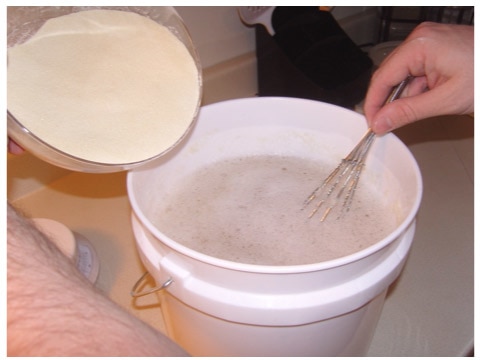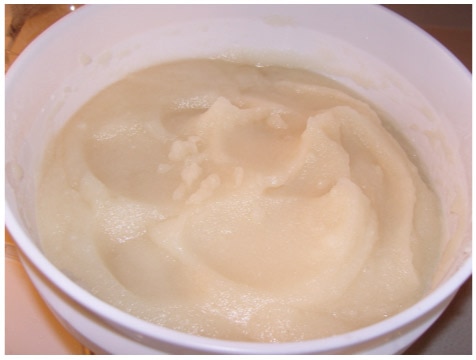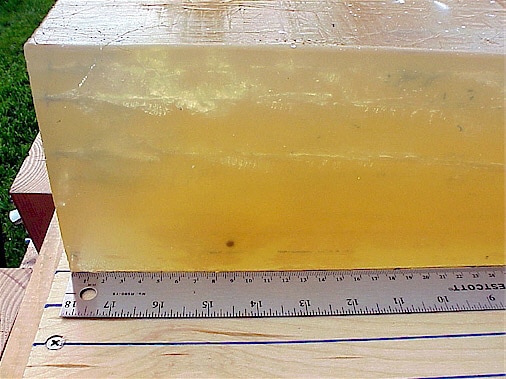
Ballistics gelatin is perhaps the most attractive media to use for your own terminal performance testing. All it takes is some know how, time, sweat and money…
Recently, Guns.com ran an article of mine focusing on terminal performance testing and materials. While I have tried a variety of test media during the course of my ballistic misadventures, I much prefer working with gelatin due to its photogenic nature and the easy cleanup it affords.
What follows is a basic guide to preparing a gelatin test block. While the procedure below is by no means the only way to approach making gel blocks, it is the method I have found to be the most convenient and hassle free.
Required tools and materials
- 250 bloom or stronger powdered gelatin (approximately 1 to 2 pounds per gallon of water, depending on desired block density).
- Cold water (distilled is used by the experts, but I have good luck with non-chlorinated tap water)
- Cinnamon oil to inhibit bacterial growth
- A large stock pot
- Plastic 2 gallon bucket
- Thermometer
- Medium to high capacity scale
- Whisk or stirring stick
- Strainer
- Cooking stove or hotplate
- Molds
- A lot of space in your refrigerator
- A wife who will let you take over the kitchen for a few hours
Step 1: Sterilize equipment and work area
Gelatin blocks can and will grow cultures of mold and bacteria. In order to minimize the amount of contaminates introduced into the gelatin, sterilize all tools and containers that will come in contact with the gelatin with a light bleach solution. Also do your best to sterilize your work area and keep your hands clean.
Step 2: Determine desired gel density
The density of a gel block depends on the weight ratio of gelatin powder to water. For a block of 10 percent density, add 1 pound of gelatin powder to 9 pounds of water. While 10 percent density is the standard for most ballistic test labs, I often mix my blocks to a density of 20 percent (2 pounds of gel to 8 pounds of water) for comparative testing. The reason I mix to such a density is that the blocks stop bullets faster than the standard ten percent, which in turn means less material to transport to the firing range. Refer to the chart below for additional mixing ratios.
Density Water (lbs) Gelatin Powder (lbs)
10% 9 1
15% 1.5 8.5
20% 8 2
Step 3: Hydrate the gelatin powder
This step can be broken down further into four parts:

Gradually stirring the gelatin into the water will minimize clumping. Mixing is easier if batches are kept small. (Photo: Jason Wimbiscus)
- Weigh out the required amount of gelatin powder and then set it aside in a place where it will not get wet.
- Place the empty two gallon bucket on the scale and set the tare to zero and pour in 8 pounds of water.
- Remove the bucket from the scale and gradually stir in the desired amount of gelatin powder. The resulting mixture will have a consistency similar to that of mashed potatoes.
- Secure the bucket’s lid in place and refrigerate for 2 to 4 hours.

Once the gel powder has been thoroughly mixed with the water, it will have a consistency similar to mashed potatoes. The mixture should be refrigerated for two to four hours before continuing with the process. (Photo: Jason Wimbiscus)
Step 4: Melt the mixture
First, place the bucket in the stockpot and add water to the pot until the bucket is sufficiently covered. It is generally a good idea to place a spacer at the bottom of the pot so that the bucket does not have direct contact with the bottom of the pot. Mason Jar rings work well for this purpose.
Then place the pot containing the bucket on the stove top and heat. Keep the heat as low as possible. In my research on how to make gel blocks various sources list maximum mixture temperatures from 104F to 140F. I have found that the gel blocks have the greatest transparency if the hydrated mixture is heated just enough to completely melt. This optimum temperature will be between 100 and 104 degrees Fahrenheit. The melting process will take substantial time and due diligence is required to make sure the mixture does not get too hot. Stir the mixture periodically during the melting process.

Use a double boiler setup to melt the hydrated gel mixture. Take care to prevent the water from actually boiling and the gel solution getting too hot. (Photo: Jason Wimbiscus)
A thick layer of foam will likely develop on the surface of the mixture. This can be skimmed off with a slotted spoon, or a net made from a fine mesh such as a nylon stocking. There are also chemical de-foaming agents that can be purchased.
Step 5: Cast the block
Remove the bucket containing the gel mixture from the pot and carefully fill the containers you are using as molds. Professional grade molds can be purchased but straight walled plastic storage containers will work in a pinch. Make sure to skim off as much foam as possible and stir in a few drops of cinnamon oil before placing the lid on the container.
Allow the mixture to cool to room temperature before refrigerating. Refrigerate at approximately 34 degrees Fahrenheit for at least 72 hours before shooting the block.

After filling the mold, allow the gel to cool to room temperature before refrigerating. Refrigerate at 34 degree Fahrenheit for 72 hours before shooting the block. (Photo: Jason Wimbiscus)
When using a flexible, plastic container, the cooled block can be removed by turning the container upside down and shaking vigorously while pulling the sides of the container away from the block. If using a metal container, a plastic liner will facilitate removal.
Tips and considerations
- Use gelatin powder of sufficient strength. The strength of gelatin is defined as bloom which is a measure of the strength of gelatin and reflects the average molecular weight of its constituents. The higher the bloom number the stiffer the gelatin. Use gelatin with a bloom strength of at least 250 for terminal performance testing. Such a product can be ordered in bulk from a number of online suppliers who specialize in the production of professional grade ordnance gelatin powder. For my tests, I use 250 bloom food grade gelatin purchased from bulkfoods.com. While the clarity of food grade gelatin is usually inferior to that of specialized ordinance gel, it is sufficient for my tests, runs a little cheaper (about $170 after shipping for 25 pounds) and can be ordered in quantities of 5 pounds or less if need be.
- Don’t try to make too large a batch of gel as the mixing process will become difficult and the size of the melting setup will be cumbersome. I have found it best not to make more than 10 pounds of mixture in a single container. If you need to make more gel than that at once, use several mixing containers and set up more than one stock pot.
- Follow all safety rules when shooting the block. Make sure a sufficient backstop is behind the block in case the bullet misses or passes through. It’s also a good idea to place a material behind the block to catch the bullet if it clears the block. Paraffin wax blocks softened by mixing with petroleum jelly will work for this, as will boxes or bags stuffed with polyester fill material. As always, wear adequate eye and ear protection.
- Place the block on a stand of sufficient strength. When shot, gelatin blocks can expand with enough force to break .75 inch plywood. I am still revising the design of my stand and will report back when I come up with something that achieves the perfect combination of portability and durability.
Calibration and scientific validity
The calibration of a gel block involves firing a steel BB into the block at a velocity of 600 f/s. In the ideal block of 10 percent gelatin, the BB should penetrate 3.25 to 3.75 inches. Mathematical formulas exist to adjust results obtained from gel blocks where the BB penetration varies from the ideal by +/- 2 inches.

Calibrating a homemade gelatin block with a BB at 600 fps. (Photo: Jason Wimbiscus)
I do not calibrate my blocks for two reasons. First, the amount of money required to purchase an air rifle capable of launching a BB at 600 f/s will also buy a lot of interesting ammo to test. Since I work with a very limited budget, I have to set my priorities appropriately. Second, I am not striving to produce test results that will stand up to scientific review as such is beyond what I can reasonably obtain working out of my kitchen. To produce thoroughly scientifically valid results, not only would I have to produce near ideal gel blocks, but I would also have to test a single load multiple times and then run a bunch of statistics calculating minimum, maximum, mean, and median penetration and expansion, as well as have to think back my college statistics class to remember what standard deviation is. Not only would such measures turn a hobby into chore, it would reduce the number of loads I could test per order of gelatin powder. Obtaining scientifically valid results from two rounds could easily cost $100.
My tests are intended to be comparative. To elaborate, I want to see how load X compares to load Y in the same batch of gelatin. Admittedly, the test results I obtain on Wednesday cannot be fairly compared to the results I obtain on Saturday, and neither set of results should be compared to what comes out of an FBI test lab. That being said, non-scientific terminal performance tests can still reveal a lot of useful information about the potential of a given load. If you want to see if that newly on the market all copper super bullet for your favorite elk round really will penetrate deeper than the budget softpoints you bought on clearance, then an amateur gel test may be in order.
The post Making photogenic gelatin blocks for backyard ballistics tests appeared first on Guns.com.
